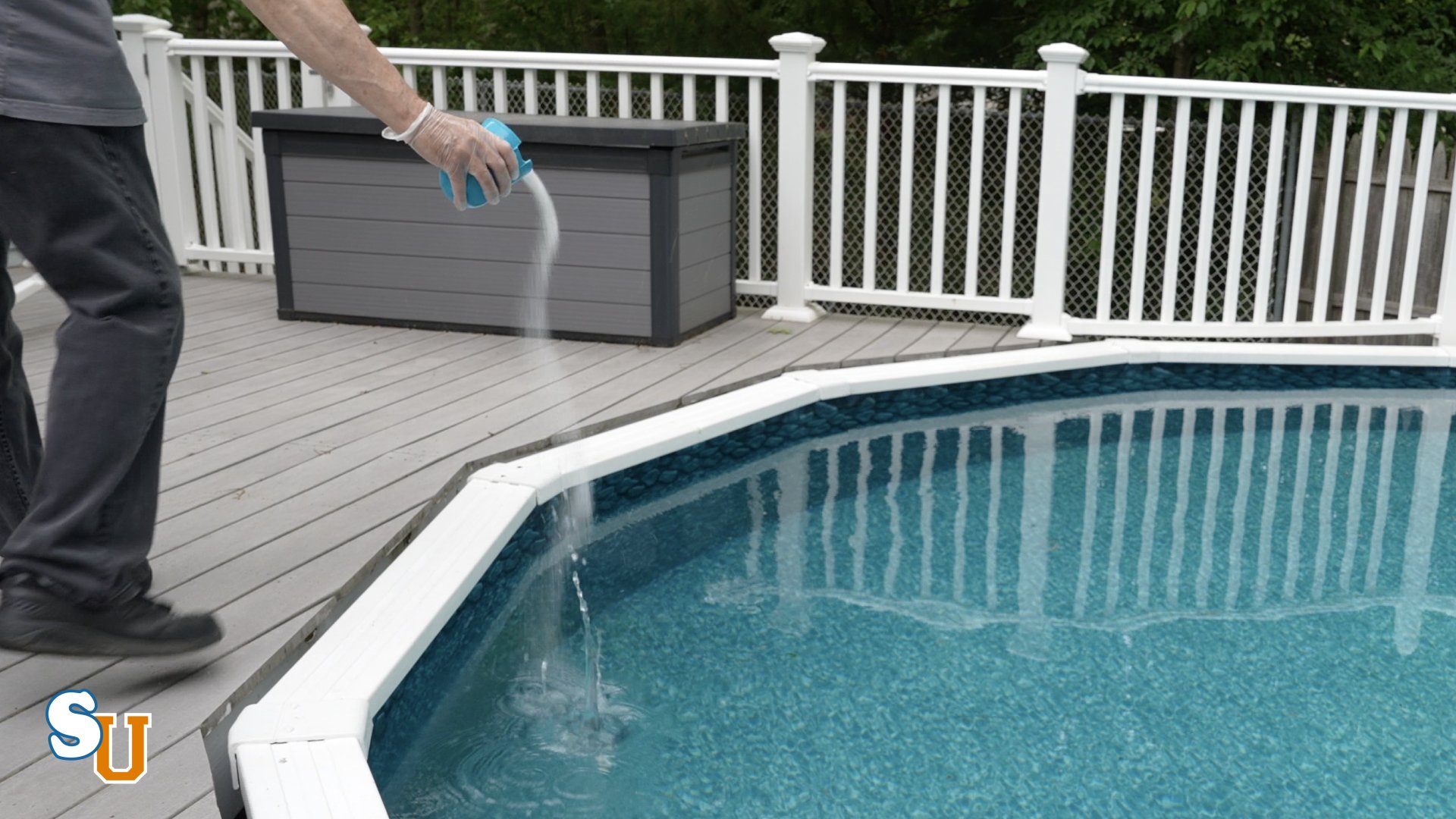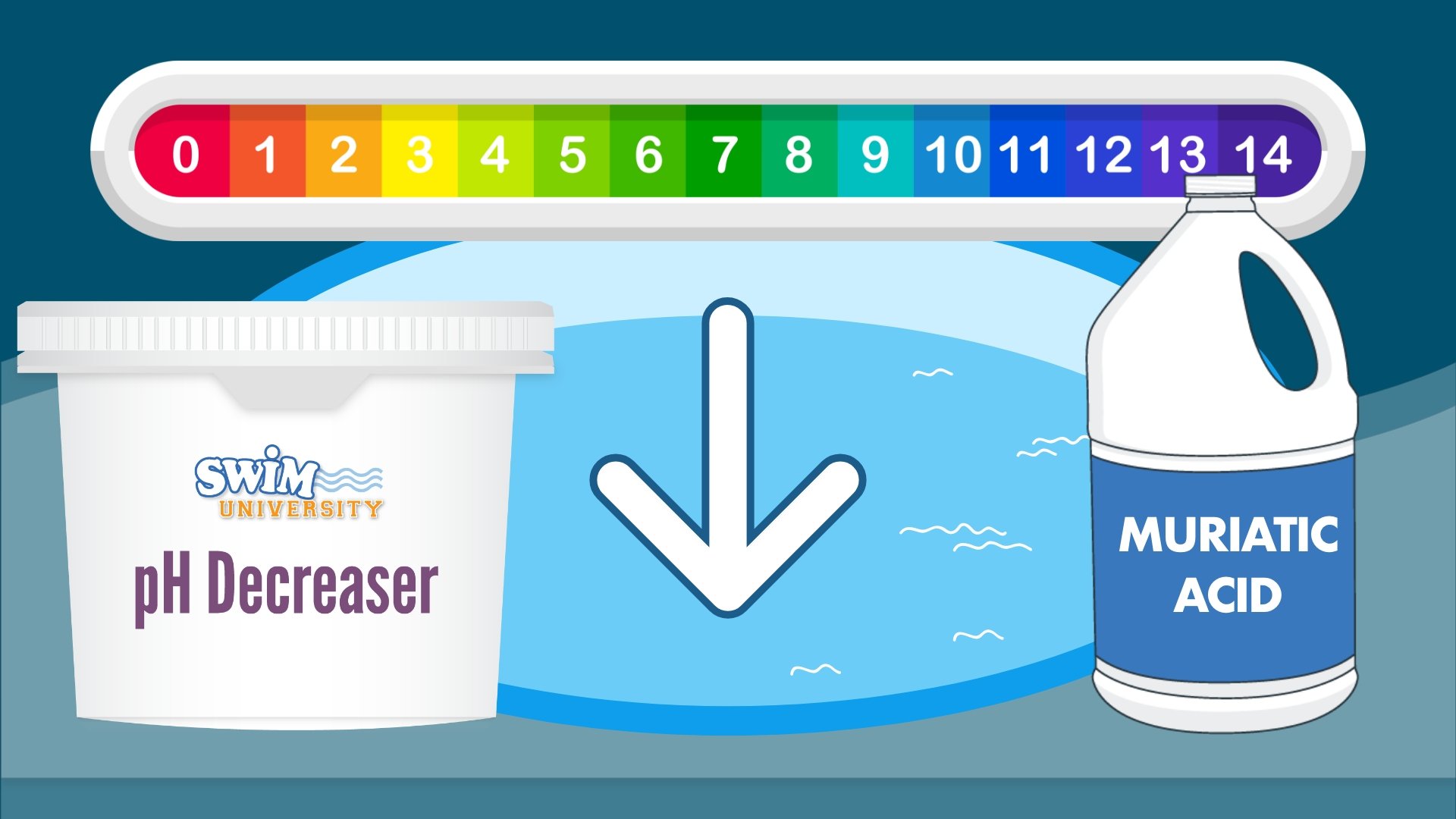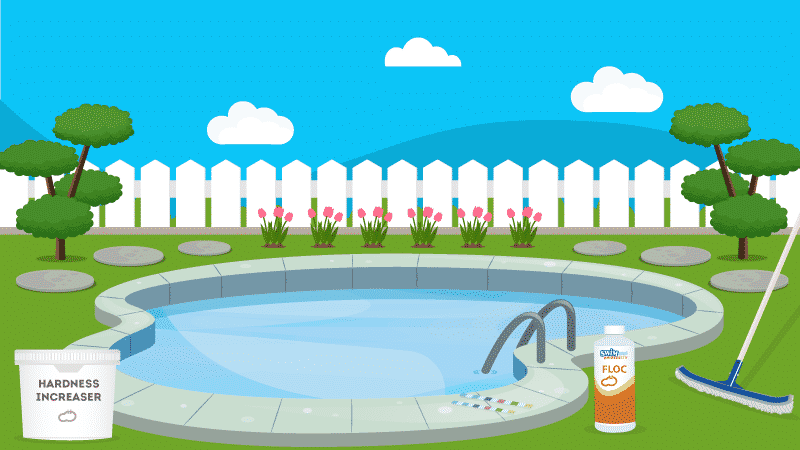How To Raise Your Pool’s Alkalinity with Baking Soda
Here’s a secret for pool owners. Some brands of alkalinity increaser have just one active ingredient: sodium bicarbonate. Well, guess what? Sodium bicarbonate is baking soda.
Baking soda raises alkalinity levels in your pool. AND it can be less expensive than Alkalinity Increaser.
How do you know if you need to increase your pool alkalinity?
Test your pool water daily. Your alkalinity levels should be between 100 and 150 ppm or parts per million. And increasing alkalinity affects pH, which should be between 7.4 and 7.6.
Stop wasting time and money with confusing water chemistry and maintenance. Our effortless system guarantees to keep your pool balanced, sanitized, and crystal clear all year. Works for all pools including saltwater.
Understanding pH Levels and Total Alkalinity in Your Pool
You can either have acidic water or basic pool water. The level of how acidic your pool water is is determined by the pH scale.
The lower the pH level, the more acidic your water will be. Acidic water can cause long-term damage to all your equipment and pool surfaces by eating away at it over time.
The higher the pH level, the more basic your water will be. Basic water can also cause damage by adding a layer of film (or scaling) to your pool parts. Do you know that white, crusty build-up you sometimes see on showerheads? That’s what can happen to your pool and all its equipment.
Here’s a visual of the pH scale. Pool water can be as low as 6 or as high as 8. Your goal is to keep it neutral. Which for a swimming pool is between 7.4 and 7.6.
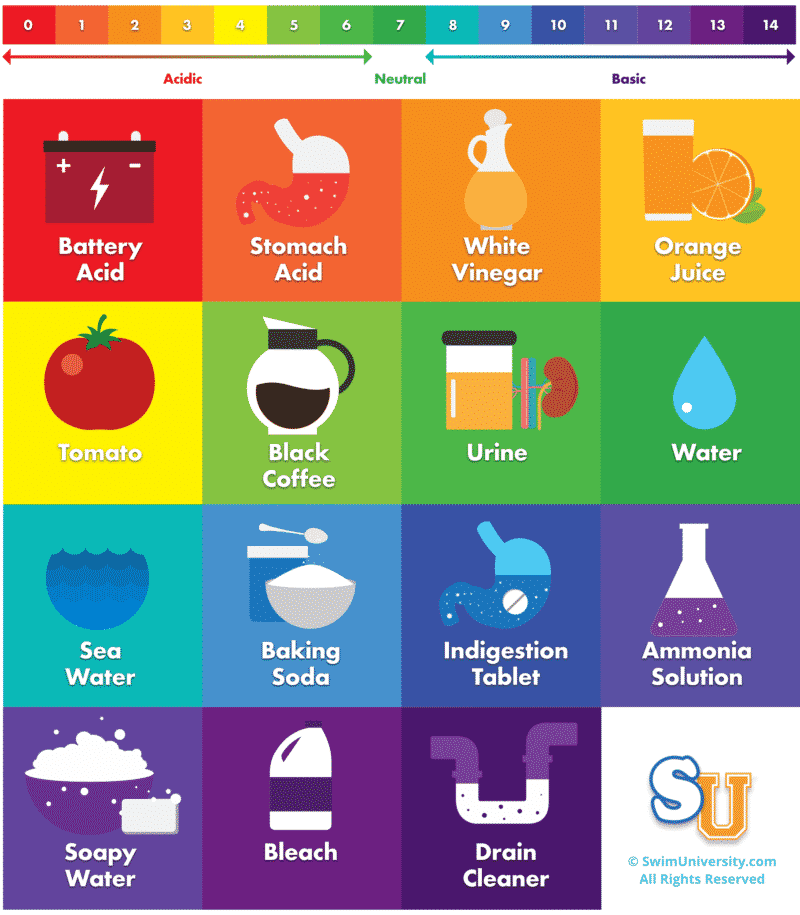
Now, alkalinity is your pH buffer. But I like to call it pH’s bodyguard. Having the alkalinity of the water between 100 and 150 ppm (parts per million) will help keep a stable pH.
For example, every time it rains or when someone jumps in the pool, that can affect your pH. It can cause it to go up or down dramatically. But alkalinity will take the brunt of the hit before your pH does. And that’s why it’s important to use the right amount of baking soda to keep both your pH and alkalinity levels correct.
How Much Baking Soda Do I Add To My Pool?
As a rule of thumb, use 1.5 pounds (680 grams) of baking soda per 10,000 gallons (37,854 liters) of pool water. This should raise the alkalinity by about 10ppm (parts per million). Or you can use the chart below.
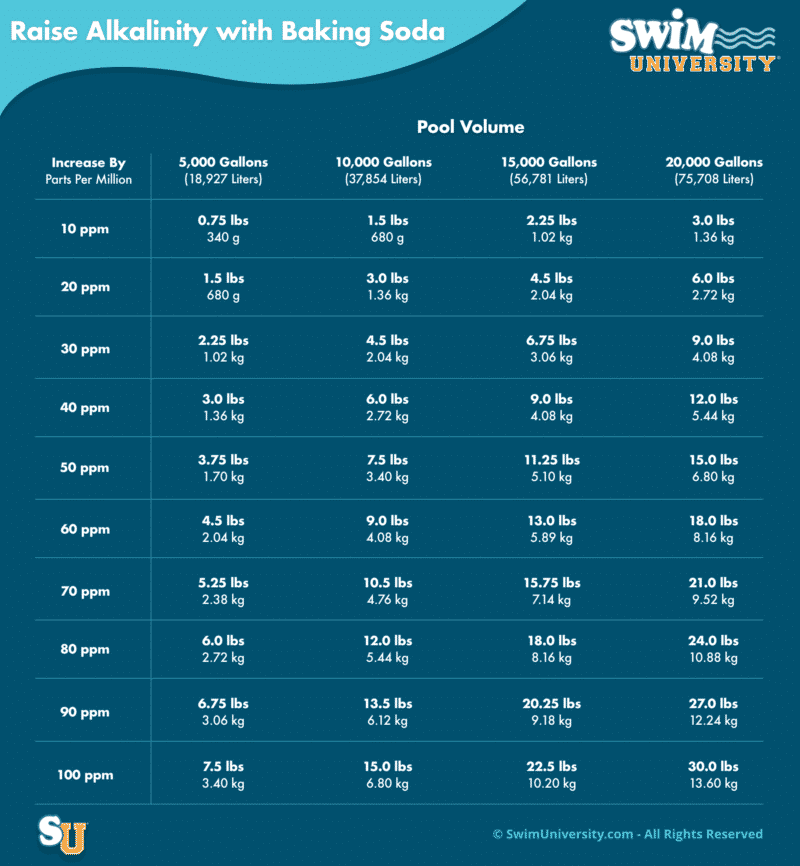
If you’re not sure how much water your pool holds, check out our pool calculator.
Once you know your pool’s volume, and you’ve measured out the baking soda, don’t add it all at once! If you adjust the alkalinity too much in either direction, it can affect the pH as well.
Note: It doesn’t matter which type of baking soda you use. The most popular brand is Arm & Hammer, which is a good choice. Any grocery store brand will do as long as the main and only ingredient is Sodium Bicarbonate.
An affordable alternative to traditional chemicals, baking soda will naturally raise the alkalinity and pH in your water. It's also useful for cleaning tiles and surfaces.
How to Add Baking Soda to Your Pool
- Start by adding just 1/2 or 3/4 of the baking soda you’ve measured out. Distribute it in wide arcs across the entire pool. This is called “broadcasting.” Wear chemical-resistant goggles and gloves. And it’s best not to do this on a windy day.
- Let the baking soda circulate and dissolve for at least six hours. Keep the filtration system running during that time. Then using a liquid test kit or test strips, check both the total alkalinity and pH levels.
- If the levels are still off, repeat the process. If they’re where they should be, congrats! You just saved money taking care of your swimming pool!
Note: We don’t recommend adding baking soda directly into your skimmer. Adding chemicals through your filter system can be dangerous especially if you have a chlorinator or chemical feeder. It’s actually easier to just add it directly to the water.
What if the Alkalinity is Too High?
- Keep the filter system running and simply wait for the alkalinity to drop down to the normal level.
- Add some water to the pool to dilute the baking soda. This will also dilute your other chemicals.
- Use muriatic acid to lower total alkalinity fast. This will also lower pH.
Baking Soda Vs. Soda Ash
Baking Soda (Sodium Bicarbonate) is used to raise alkalinity and also slightly raise pH. And Soda Ash (Sodium Carbonate) is used to raise pH and slightly raise alkalinity.
For example, getting a pH reading around 7.2 to 7.6 in 10,000 gallons (37,854 liters) of pool water would take roughly 21 pounds of baking soda. This would also increase the Total Alkalinity by roughly 150 ppm (parts per million). And that’s way too much!
But if we wanted to increase the pH of the pool by 0.5, we could use roughly 12 ounces (340 grams) of soda ash. That would only increase the total alkalinity by roughly 8 ppm.
In other words, use baking soda to increase alkalinity and soda ash to increase pH.
Does Baking Soda Kill Algae in Pools?
No. But keeping your pH and alkalinity properly balanced helps maintain a stable chlorine level which helps kill pool algae and keep it out of the water. However, if you have a green pool, then you need to follow our detailed instructions on getting rid of pool algae and keep it from coming back. You can also try using an algaecide, too.
Will Baking Soda Clear Up a Cloudy Pool?
Not directly, but it can help. If your water is under-sanitized and causing cloudiness, then you want to make sure your pH and alkalinity are balanced before adding sanitizer.
That said, adding too much baking soda at once can cause your pool water to be cloudy. Usually, you just have to wait for it to fully dissolve, so don’t panic. High alkalinity can also cause cloudy water.
Are There Any Risks With Putting Baking Soda in Your Pool?
While there’s no risk in using baking soda in your pool, there are risks to having high and low alkalinity.
You might notice corrosion in and around your ladders, liner, tiles, or other parts of your pool. This is likely due to low pH and alkalinity for long periods of time.
And if you see scaling or a build-up around your pool equipment, this could be caused by high pH and alkalinity. And it means your water is hard.
All you have to do is keep the alkalinity between 100 and 150 ppm and the pH between 7.4 and 7.6 as often as possible. Test your pool water daily and adjust your chemical levels when needed.
What About Health Risks?
We mentioned getting it in your eye if you add it to your pool on a windy day. That hurts like hell. But besides that, sodium bicarbonate (aka baking soda) is relatively safe.
Sodium bicarbonate has been used for thousands of years. Most notably by Ancient Egyptians who used it to clean their teeth. Just like we do today!
And it’s “Generally Recognized as Safe” by the FDA as a direct food additive.
Think of it this way, if it’s safe enough to use in cakes, then your swimming pool won’t be a problem.
Baking Soda In Pool Water Will Save You Money
The best part about all this is that baking soda is often cheaper than an alkalinity increaser. And you can buy baking soda in bulk just like the pool supply store brand.
On top of that, you can always use any extra baking soda to brush your teeth, make a cake, or clean your dishes.
Happy Swimming!
3 Ways We Can Help With Your Pool
- Pool Care Cheat Sheets (Free): Easy-to-use downloadable guides to help you keep track of taking care of your pool this year.
- The Pool Care Handbook: An illustrated guide to DIY pool care, including water chemistry, maintenance, troubleshooting, and more.
- The Pool Care Video Course: You’ll get 30+ step-by-step videos and a downloadable guide with everything you need to know about pool maintenance.








